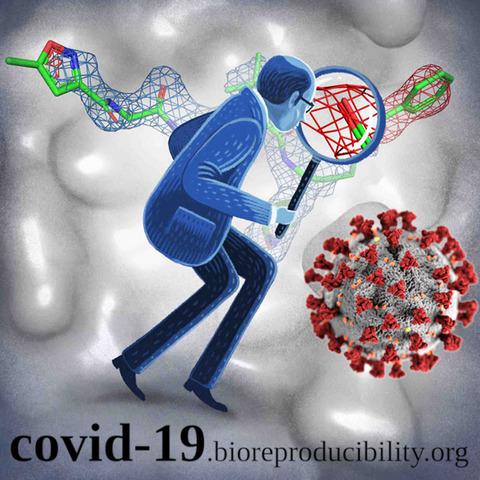Our official English website, www.x-mol.net, welcomes your
feedback! (Note: you will need to create a separate account there.)
Ligand-centered assessment of SARS-CoV-2 drug target models in the Protein Data Bank.
The FEBS Journal ( IF 5.5 ) Pub Date : 2020-05-17 , DOI: 10.1111/febs.15366 Alexander Wlodawer 1 , Zbigniew Dauter 2 , Ivan G Shabalin 3 , Miroslaw Gilski 4, 5 , Dariusz Brzezinski 3, 5, 6 , Marcin Kowiel 5 , Wladek Minor 3 , Bernhard Rupp 7, 8 , Mariusz Jaskolski 4, 5
The FEBS Journal ( IF 5.5 ) Pub Date : 2020-05-17 , DOI: 10.1111/febs.15366 Alexander Wlodawer 1 , Zbigniew Dauter 2 , Ivan G Shabalin 3 , Miroslaw Gilski 4, 5 , Dariusz Brzezinski 3, 5, 6 , Marcin Kowiel 5 , Wladek Minor 3 , Bernhard Rupp 7, 8 , Mariusz Jaskolski 4, 5
Affiliation

|
A bright spot in the SARS‐CoV‐2 (CoV‐2) coronavirus pandemic has been the immediate mobilization of the biomedical community, working to develop treatments and vaccines for COVID‐19. Rational drug design against emerging threats depends on well‐established methodology, mainly utilizing X‐ray crystallography, to provide accurate structure models of the macromolecular drug targets and of their complexes with candidates for drug development. In the current crisis, the structural biological community has responded by presenting structure models of CoV‐2 proteins and depositing them in the Protein Data Bank (PDB), usually without time embargo and before publication. Since the structures from the first‐line research are produced in an accelerated mode, there is an elevated chance of mistakes and errors, with the ultimate risk of hindering, rather than speeding up, drug development. In the present work, we have used model‐validation metrics and examined the electron density maps for the deposited models of CoV‐2 proteins and a sample of related proteins available in the PDB as of April 1, 2020. We present these results with the aim of helping the biomedical community establish a better‐validated pool of data. The proteins are divided into groups according to their structure and function. In most cases, no major corrections were necessary. However, in several cases significant revisions in the functionally sensitive area of protein–inhibitor complexes or for bound ions justified correction, re‐refinement, and eventually reversioning in the PDB. The re‐refined coordinate files and a tool for facilitating model comparisons are available at https://covid-19.bioreproducibility.org.
中文翻译:

蛋白质数据库中 SARS-CoV-2 药物靶标模型的以配体为中心的评估。
SARS-CoV-2 (CoV-2) 冠状病毒大流行的一个亮点是生物医学界立即动员起来,致力于开发 COVID-19 的治疗方法和疫苗。针对新兴威胁的合理药物设计依赖于成熟的方法,主要利用 X 射线晶体学,提供大分子药物靶标及其与药物开发候选物的复合物的准确结构模型。在当前的危机中,结构生物学界通过展示 CoV-2 蛋白的结构模型并将其存放在蛋白质数据库 (PDB) 中做出了回应,通常没有时间限制,并且在发表之前。由于一线研究的结构是在加速模式下产生的,因此出错和错误的可能性增加,最终有阻碍的风险,而不是加快药物开发。在目前的工作中,我们使用了模型验证指标,并检查了截至 2020 年 4 月 1 日 PDB 中可用的 CoV-2 蛋白质和相关蛋白质样本的沉积模型的电子密度图。我们将这些结果与旨在帮助生物医学界建立更有效的数据池。蛋白质根据其结构和功能分为几组。在大多数情况下,不需要大的修正。然而,在某些情况下,蛋白质-抑制剂复合物的功能敏感区域或结合离子的重大修订证明了 PDB 中的校正、重新改进和最终恢复是合理的。在 https://covid-19.bioreproducibility.org 上提供了重新优化的坐标文件和便于模型比较的工具。
更新日期:2020-05-17
中文翻译:

蛋白质数据库中 SARS-CoV-2 药物靶标模型的以配体为中心的评估。
SARS-CoV-2 (CoV-2) 冠状病毒大流行的一个亮点是生物医学界立即动员起来,致力于开发 COVID-19 的治疗方法和疫苗。针对新兴威胁的合理药物设计依赖于成熟的方法,主要利用 X 射线晶体学,提供大分子药物靶标及其与药物开发候选物的复合物的准确结构模型。在当前的危机中,结构生物学界通过展示 CoV-2 蛋白的结构模型并将其存放在蛋白质数据库 (PDB) 中做出了回应,通常没有时间限制,并且在发表之前。由于一线研究的结构是在加速模式下产生的,因此出错和错误的可能性增加,最终有阻碍的风险,而不是加快药物开发。在目前的工作中,我们使用了模型验证指标,并检查了截至 2020 年 4 月 1 日 PDB 中可用的 CoV-2 蛋白质和相关蛋白质样本的沉积模型的电子密度图。我们将这些结果与旨在帮助生物医学界建立更有效的数据池。蛋白质根据其结构和功能分为几组。在大多数情况下,不需要大的修正。然而,在某些情况下,蛋白质-抑制剂复合物的功能敏感区域或结合离子的重大修订证明了 PDB 中的校正、重新改进和最终恢复是合理的。在 https://covid-19.bioreproducibility.org 上提供了重新优化的坐标文件和便于模型比较的工具。











































 京公网安备 11010802027423号
京公网安备 11010802027423号